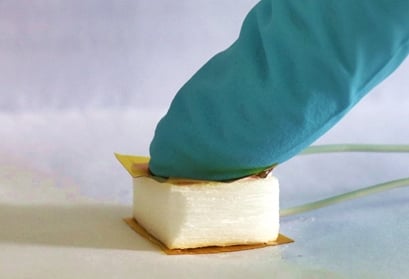
A team led by Ingo Burgert at Empa – the Swiss Federal Laboratories for Materials Testing and Research – and ETH Zurich has repeatedly shown that wood is more than just a building material or firewood. Scientists are looking for ways to extend the properties of wood to make it suitable for completely new applications such as high-strength, water-repellent or magnetizable wood. The latest research project, conducted by the team in collaboration with the Empa research group led by Francis Schwarze and Javier Ribera, involved a simple, environmentally-friendly method of generating electrical voltage using a type of wooden sponge.
Piezoelectric effect
“If you want to generate electrical voltage with wood, the so-called piezoelectric effect comes into play,” the researchers explain. Piezoelectricity means that the elastic warping of solids generates electrical voltage. This is nothing new, but until now this phenomenon has mainly been used in measurement technology using sensors that generate a charge signal when subjected to mechanical stress, for example. However, these sensors often use substances such as lead zirconate titanate (PZT) and are therefore inappropriate for use in biomedicine since lead is not suitable for use on the skin. In addition, the ecological disposal of these materials is very difficult.
This is in stark contrast to the natural piezoelectric effect of wood, which has clear advantages and whose effect could also be used for sustainable energy generation. But wood must first have the appropriate properties for this. Without special treatment, only a very low electrical voltage is generated when the wood is subjected to mechanical stress.
From block to sponge
To give the wood these necessary properties, Jianguo Sun, a doctoral student on Burgert’s team, used a process that forms the basis for various additional developments: delignification. Wood cell walls consist of three basic substances: lignin, hemicellulose and cellulose. “A tree needs the lignin primarily to be able to grow to a great height,” Burgert explains. “Without lignin as a stabilizing substance connecting the cells and preventing the tensile cellulose fibrils from buckling, this would not be possible.”

Here’s how a piezoelectric nanogenerator works: After the rigid wood structure is dissolved, a flexible cellulose network remains. When this is compressed, charges are separated and an electrical voltage is generated. Image: ACS Nano/Empa
To convert wood into an easily formable material, the lignin would have to be at least partially “dissolved out” by placing it in a mixture of hydrogen peroxide and acetic acid. The lignin then dissolves in this acid bath. What’s left is a white wooden sponge made of thin layers of cellulose, one on top of the other. These can be easily pressed together and also expand back to their original shape. The goal of Burgert’s team with this process was to work with relatively simple and environmentally friendly processes: “We take advantage of the hierarchical structure of the wood without having to first dissolve it, as in paper production, and then reconnect the fibers.”
Electricity from the floor
A test cube about 1.5 cm long was put through about 600 load cycles. In the process, the material showed “amazing stability.” The researchers measured a voltage of about 0.63 V with each load. That would be enough to use it as a sensor. In further experiments, the researchers were able to show that 30 such wooden blocks, when subjected to the equivalent of an adult’s body weight at the same time, would already cause a simple LCD display to light up. If the process were further optimized, it would even be possible to create a functional parquet floor that converts the energy from footsteps into electricity. The scientists also tested its suitability as a pressure-sensitive sensor on human skin, enabling them to show that an application in the medical field would also be possible.

A nanogenerator: After the rigid wooden structure (left) has been dissolved in acid, flexible cellulose layers remain (center/right). When pressed together, differently charged areas are pushed against each other. The surface of the material becomes electrically charged. Photo: ACS Nano / Empa
Research continues
In the future, however, the researchers want to go one step further. They want to modify the process so that no aggressive chemicals are needed. And they found a suitable candidate in nature: the fungus Ganoderma applanatum, which causes white rot in wood. “The fungus breaks down the lignin and hemicellulose in the wood particularly gently,” says Empa researcher Javier Ribera, explaining the environmentally-friendly process. Plus, the process can be easily controlled in the laboratory.
It will be some time before the “piezo” wood can be used in practice as a sensor or electricity-generating parquet flooring. But the scientists are already working on further research and are in talks with possible cooperation partners. They published the results of their research in the renowned journal Science Advances.
Cover photo: Even low pressure can generate electrical voltage in the wood sponge. Image: © ACS Nano / Empa

